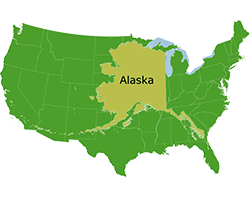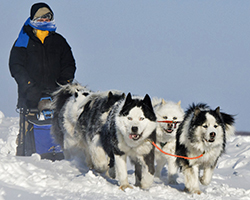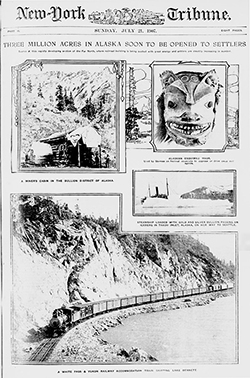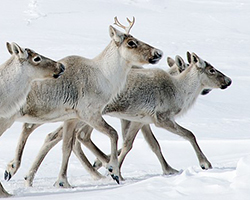Indigenous Peoples in a changing land

Alaska is the most northern and only Arctic state in the United States. It is an immense state that if laid were over the 48 contiguous (connected) states it could cover most of the western states. It has the longest coastline of any state; the coast creates the Gulf of Alaska, the Bering Strait, and runs along the Arctic Ocean.
As Indigenous People of Alaska, this has been our homeland for thousands of years. The Indigenous People of Alaska are known legally as Alaska Natives. Our families and ancestors have lived in Alaska for generations and are the first stewards of the land. The land and waters, including our surrounding oceans, seas, and many rivers and lakes have always provided for our way of life. The Earth's land and water gives us food by the fish, birds, animals, and plants we rely on. It also has given us the shelter, clothing and many traditions that we practice and celebrate.
As Indigenous People of Alaska we see that we are part of a healthy ecosystem, not separate from it. We rely on healthy lands, air, and waters, and all species. Because we are part of the ecosystem these things all rely on us, too.
Ecosystem is a two-part word, made by combining "eco" and "system." The root of the word, eco, means home, while system can be thought of as an interconnected network. For example, Inuit People, which include Indigenous people from Inuit Nunaat, or Inuit Homeland that includes parts of Alaska, Canada and Greenland, have an idea or concept of a healthy arctic ecosystem that shows that people, or humans are a part of this ecosystem, part of the whole system.
Alaska lands, waters and many different species are rapidly changing. Indigenous People, who have lived in the Alaskan Arctic and sub-arctic for generations, see how climate change is affecting our collective world, especially across Alaska and surrounding waters. It disrupts the seasons, changing when they start and end. It hurts our unique fish, marine mammals, animals, birds, and plants, and lessens their numbers. It is changing our way of life.

In Alaska, about 80% of the population living in remote rural areas are Indigenous Peoples. Our parents and family members, along with the whole village, pass down stories and lessons about the land and the animals to our children. This helps build a deep connection with the land. Our way of life depends on the land and waters to provide food, shelter, transportation, and other things we need to live on.
Colonialism in Alaska
Centuries of colonialism have made it hard for us as Indigenous Peoples to hold on to our ways of life. Around 1741 Russia colonized Alaska and claimed the land as their own. In 1867, the United States bought Alaska from Russia. This was done without involvement of Alaska Natives. We also did not agree to or approve of this sale. Alaska later became the 49th state in the USA.
Prospectors, fur traders, missionaries, and early business men along with judges and school teachers came with the idea of seeking riches and benefiting from Alaska, or to have adventure, obtain land or "save" the soul of Alaska Native people with religion. This is a colonizer belief system. It allows for individual gain, while often not looking at and doing things for the good of everyone, or the land, water and animals.

Many of these colonizers were people who had common jobs, like teachers or businessmen. Others wanted to find gold or to hunt animals for their furs, so they could benefit from Alaska's limited resources. There were also those who came to try to spread their religion to the native people.
Russian colonizers enslaved Indigenous peoples and forced them to harvest sea otters for their fur. The sea otter nearly went extinct in that area. The Steller’s sea cow, a type of manatee, went extinct from overharvesting just a few years after the arrival of colonizers. Colonization is not just a thing of the past. A colonizing mentality still controls many of the people and affects the land today.
Colonial economies have a history of taking too much from the land or water, like cutting too many trees or taking too much fish. Mismanaging and polluting the land, animals, and waters is also common. One example of this is with the marine mammal, the whale.
In contrast, Indigenous cultures rely on deep knowledge by watching and listening to life around them. This knowledge is often passed down through generations, to care and have respect for the land. We show this by the belief in “not taking more than what is needed” so that the environment can stay strong and healthy. This belief was and is threatened by colonialism. Many Native Alaskan cultures are still struggling to keep their way of life and protect the lands they and the animals, plants, birds call home.

Early colonizers came with the idea of changing Alaska Native people. This was often done through churches and schools. Children were taken from their homes and required to attend school elsewhere. Many children were made to travel hundreds of miles to boarding schools to land different from their home area. Kids were not allowed to speak their language, wear their traditional clothing, or talk about their culture.
Boarding school students remember hearing the smaller children crying in their wings. Children who spoke their Native tongue were commonly punished. Many children were abused in these boarding schools. A legacy of trauma persists through the families of the boarding school survivors, some of whom are still alive. It’s important to listen to their stories, learn about their culture, and acknowledge what they lost. Colonialism still exists around the world. We can fight it by giving marginalized voices a meaningful platform to speak.
Changing climate, changing places
Climate change in Alaska affects all forms of life from the huge walrus to the small clams or to ice algae. You can see the ways these different species connect to each other and to climate change with the EcoChains: Arctic Futures card game. Climate change is rapidly changing the sea ice, which is melting and becoming less reliable.
Such changes in the Arctic can harm the food webs and make it hard for people, animals, and plants that live there. The walrus numbers are decreasing along with other species that live in Alaska and rely on sea ice. This includes sea otters, salmon, polar bears, and caribou. Many of these animals mean a lot to Arctic residents.

These animals help support Alaska Native groups’ way of life. This means that climate change is harming humans and their unique cultures, as well as the Lands and Waters around them. Many groups around the world and in Alaska are working on plans of action to help the Arctic, and these plans are stronger when they include Alaska Native voices.
The warming in the Arctic is being caused by what we are doing around the rest of the world. So one of the best things that you can do to help the Arctic ecosystem is to get your family and friends, along with community members, businesses, and governments to take action to reduce greenhouse warming.
About the authors: Malinda Chase is a Tribal Liaison for the International Arctic Research Center; Leah Shaffer is a graduate student of sustainability and resource economics at Arizona State University.
Image of Stellar's sea cow from the Biodiversity Heritage Library via Wikimedia Commons.
Read more about: Changing Life in the Arctic
Bibliographic details:
- Article: Indigenous Peoples of Alaska
- Author(s): Malinda Chase, Leah Shaffer
- Publisher: Arizona State University School of Life Sciences Ask A Biologist
- Site name: ASU - Ask A Biologist
- Date published:
- Date accessed:
- Link: https://askabiologist.asu.edu/Alaska-Natives
APA Style
Malinda Chase, Leah Shaffer. (). Indigenous Peoples of Alaska. ASU - Ask A Biologist. Retrieved from https://askabiologist.asu.edu/Alaska-Natives
Chicago Manual of Style
Malinda Chase, Leah Shaffer. "Indigenous Peoples of Alaska". ASU - Ask A Biologist. . https://askabiologist.asu.edu/Alaska-Natives
Malinda Chase, Leah Shaffer. "Indigenous Peoples of Alaska". ASU - Ask A Biologist. . ASU - Ask A Biologist, Web. https://askabiologist.asu.edu/Alaska-Natives
MLA 2017 Style

Be Part of
Ask A Biologist
By volunteering, or simply sending us feedback on the site. Scientists, teachers, writers, illustrators, and translators are all important to the program. If you are interested in helping with the website we have a Volunteers page to get the process started.

